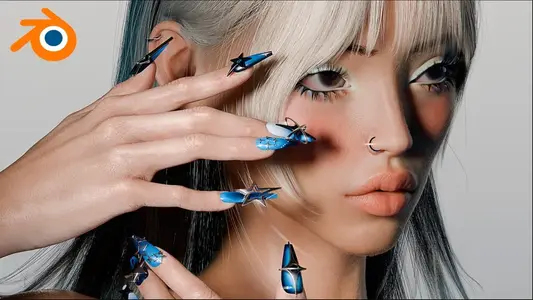- Sep 26, 2025
- 25
- 4
Y2K Nail Artwork Breakdown BLENDER is a short, project-based walkthrough that shows how to model, shade and light hyper-styled Y2K press-on nails entirely inside Blender 3D. The focus is on chrome textures, frosted glass, micro-rhinestones and holographic decals—everything that screams early 2000s nostalgia—without using any external render engines.
Introduction
Y2K Nail Artwork Breakdown BLENDER was shared by digital artist Laliett on Patreon as a one-video mini-course. Instead of painting real nails, the tutorial uses Blender to build a reusable 3D press-on kit. The result is Instagram-ready mock-ups that brands and nail techs can drop straight into their shops. No prior sculpting experience is needed—just Blender 3.0+ and a basic understanding of the shader editor.
Workflow Highlights
The lesson starts with a simple curve-based nail bed, converts it to mesh, then adds a subtle C-curve with the lattice modifier. Next comes multi-layer shading: a base chrome using the Glossy BSDF with low roughness, a frosted tip via weight-painted mix shader, and a holographic overlay driven by a noise-textured emission mask. Micro-rhinestones are placed with a hair-particle system on vertex groups, keeping the viewport light. Final glam is achieved with area lights, a 360° HDRI from Poly Haven and a peachy photographic backdrop.
Why This Breakdown Is Gold
Most Y2K nail content online is filmed IRL with gel and chrome powder—hard to replicate if you’re a 3D generalist. This Blender-only approach gives full creative control: change nail shape in seconds, swap decals via drag-and-drop, and render at 4K for print or socials. Because everything is procedural, you can re-sell the digital kit on Gumroad or offer mock-ups to press-on brands without worrying about copyright strikes.
Practical Uses
Freelancers can pitch hyper-real nail mock-ups to indie beauty brands. Nail techs preview custom designs for clients before spending on products. 3D apparel artists drop the nails straight onto metaverse avatars. Even phone-case designers reuse the chrome shader for matching accessories. The file is light—under 20 MB—so you can append it into larger fashion scenes without bloating memory.
Ease of Learning
The entire walkthrough runs 28 minutes and is voiced at a calm pace. Keyboard shortcuts flash on screen, and the project file is included. If you can make a donut in Blender, you can finish this. No paid add-ons; only built-in tools plus free community HDRI. A short bonus clip shows how to bake the textures for real-time apps like Augmented- Reality try-on filters.
Expert Review
The tutorial nails (pun intended) the Y2K aesthetic—icy metallics, butterfly decals and chunky gems—while keeping geometry clean for fast renders. Using particles for rhinestones is smarter than duplicating meshes by hand, and the holographic shader is a clever hack of the layer weight node. The only miss is lack of UDIM setup for ultra-close macro shots, but that’s beyond beginner scope anyway.
Quick Insights
Y2K Nail Artwork Breakdown BLENDER proves you don’t need a salon to create viral nail content—just a free 3D suite and 30 focused minutes. Build once, re-colour infinitely, and keep 100 % of the profit. It’s a tiny time investment that opens a brand-new revenue stream in the booming press-on market.
Learn More & Explore: Official Reference
Frequently Asked Questions
Q1. Do I need a drawing tablet?
A1. No, all shaping is done with mouse and keyboard shortcuts.
Q2. Can I export the nails to other software?
A2. Yes, the final mesh is vanilla OBJ with PBR textures; import into Cinema 4D or Substance Painter easily.
Q3. Is the holographic effect render-engine heavy?
A3. Cycles handles it at 128 samples with OptiX denoise; render time under 45 s on RTX 3060.
Q4. Commercial use allowed?
A4. The instructor grants full licence for resale of your own variants; just don’t redistribute the original source file.


